This website is supported by its readers. If you click one of my links I may earn a commission. I am also a participant in the Amazon affiliates program and I will also earn a commission from qualified purchases.

With more and more of us working from home than ever before, a lot of us (myself included) are turning to indoor plants and trees as a way to add a pop of color and greenery to our homes. Flowering trees in particular are surging in popularity. With so many trees on the marketplace, a lot of us are now asking what are the best 10 flowering indoor trees?
Fukien Tea, Crabapple, Magnolia, and Snow Rose are amongst the best flowering indoor trees to invest in. Other flowering trees such as Azalea and Jasmin can also be grown successfully indoors with a few tweaks.
So what are the benefits and drawbacks of each of these trees? And how exactly do you care for flowering indoor trees? Keep reading to find out more!
Just a quick heads up, over the past three years of running Plantpaladin, hundreds of people have asked for product recommendations. As such, You can find my favorite indoor bonsai tree here (link takes you to Bonsaiboy), my favorite outdoor bonsai tree (link takes you to Bonsaiboy), or have a look at all the products I recommend here.
Azalea
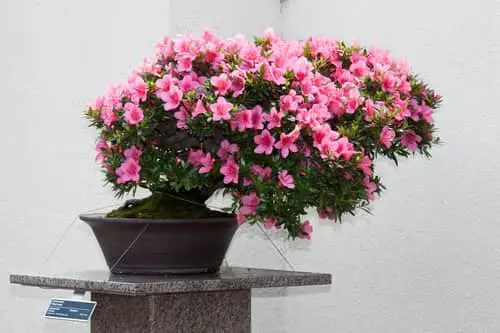
So first up we have Azalea trees.
I know what you’re thinking:
- Aren’t azaleas shrubs
- Can’t you only grow Azaleas outside
The truth is that Azaleas make for fantastic bonsai trees if grown correctly and also can be grown indoors with a few tweaks.
First, ensure you grow these trees in cooler conditions – typically between 16 to 18 degrees Celsius or 60 – 65F.
It’s also important to ensure that the tree never ends up drying out as they will get a lot less moisture indoors than they would have got in cooler temperatures outdoors.
Just be aware however that these indoor trees can be highly toxic to both pets and people so ensure they are kept out of harm’s way.
Azalea flowering indoor trees – quick facts
Azalea bonsai | Requirements |
Water | Water if dry to touch - once per day as a minimum. Water once per week in the winter. |
Sunlight | 4 hours of direct sunlight - keep in a shaded spot. |
Fertilizer | Once per month in the spring and summer - Avoid fertilizing in the winter. |
Growth rate | Slow growing - 1 to 5 inches of growth per year. |
Repotting | Repot once every 3 years. |
What do Azalea flowers start to show?
Azalea flowers will typically start to show between May and June
What color are Azalea flowers?
Azalea flowering indoor trees, come in a wide variety of colors including pink, purple, red, white, orange, and off-white colors.
Advantages and disadvantages of Azalea trees
Advantages of Azalea include:
- Smell pleasant – Some Azalea varieties not only have beautiful-looking flowers but also smell very nice too.
- Easy to care for – Azaleas are pretty low maintenance only really requiring general care, ensuring they are watered regularly and provided with enough sunlight.
- Can be kept outdoors– Whilst Azalea can be grown indoors successfully, they thrive outdoors making them ideal for those of you living in areas with cold winters and warm summers.
The main disadvantages of azalea bonsai are:
- White flowers are rare – Most Azaleas come with red or pink flowers, so finding different color varieties can prove more difficult.
- Very toxic – The biggest disadvantage to this species is that they are very toxic, even in small portions to dogs, cats, and rabbits, and should be avoided if you own kids or have young children
- Attract pests – The bright white flowers will attract more pests than some of the other species on this list – even in indoor environments.
Fukien Tea
Next up, and easily my favorite on this list is Fukien Tea trees.
When in bloom, these flowers produce tiny bright white flowers that dot over the tree adding a nice pop of color to your tree collection.
These trees can be grown in their natural form and left to mature, or transformed into a fantastic indoor bonsai tree species.
These trees are also notoriously beginner-friendly meaning that if this is your first attempt at growing flowering indoor trees, then they will be your best bet.
Fukien Tea flowering indoor trees – quick facts
Fukien Tea | Requirements |
Water | Water if dry to touch - once per day as a minimum. Water once per week in the winter. |
Sunlight | 6 hours of direct sunlight. Place near a window if kept indoors |
Fertilizer | Once per month in the spring and summer - avoid fertilizing in the winter. |
Growth rate | Slow; 1 to 5 inches of growth per year. |
Repotting | Once every 2 years |
What do Fukien Tea flowers start to show?
The flowers of a Fukien tea typically bloom in the spring and summer between March and August. That being said, if the temperature is maintained correctly, these can bloom flowers all year round.
What color are Fukien Tea flowers?
Fukien Tea Trees produce tiny white flowers across their branches and leaves. These flowers will be most permanent during the spring and summer but should be visible throughout the year.
Advantages and disadvantages of Fukien Tea trees
Advantages of the Fukien tea tree include:
- They can produce fruit – If pollinated, these will produce bright red berries to go alongside the flowers – further adding to this tree’s visual appeal.
- Easy to care for – These trees are also very beginner-friendly and thrive in indoor conditions – this means pests that attack other indoor trees won’t attack Fukien Tea.
- A lot of knowledge out there – As these species are so commonplace – with a lot of people keeping these trees indoors. , the breadth of knowledge in caring for these trees is massive.
- Bloom year-round – These flowering indoor trees are rare in the sense that they produce flowers pretty much year-round.
Disadvantages of Fukien Tea trees
- The flowers are small – Unlike other flowering indoor trees on this list, the flowers that this tree produce is much smaller in size.
- Can’t be kept outdoors – If you want to move your Fukien Tea outdoors during the summer or spring then in most mild temperatures, you won’t be able to, due to this tree needing much warmer conditions.
Cherry blossom
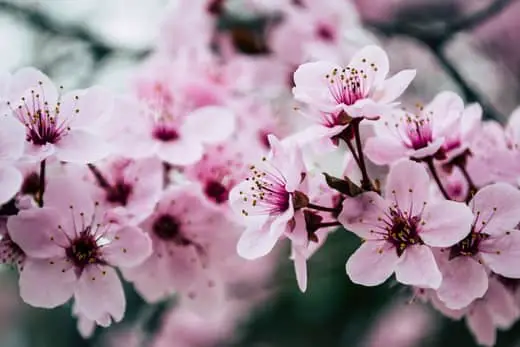
Walk past any neighborhood during the spring and no doubt eventually you will come across the bright pink falling flowers of a cherry blossom tree.
It’s not an understatement to say that these trees are stunning, and can often be the showstopper of any collection.
What is an understatement however is not knowing that with a little bit of work these flowering trees can be successfully grown indoors in a pot.
Now cherry blossoms are not one tree but come in hundreds of different varieties depending on the cherries they produce.
For growing indoors then, it is best to stick to a Cherry Blossom that has lower chill hours (600 or fewer works well).
Cherry blossoms that are grown in a pot indoors then should also be of dwarf or semi-dwarf varieties.
Royal Crimson and Lapins, for example, will work especially well for this.
I’d also recommend opting for a cherry blossom verity that is self-fertilizing.
This will save you space and will allow you to invest in one cherry tree as opposed to multiple.
To care for, simply place in a bright sunny room near a south-facing window, and water regularly ( when the soil is dry to touch)
Cherry Blossom flowering indoor trees – quick facts
Cherry Bonsai Requirements | Detail |
Water | Once per day in summer, twice per week in winter. Touch to see if the topsoil is dry before watering. Do not water when topsoil is wet. |
Sunlight | 8 hours of direct sunlight in the warm summer months |
Fertilizer | Once per month in the spring and summer. No fertilizing in the fall and winter |
Soil mix | Akadama and volcanic rock mix |
Location | Outdoor and indoors if kept in a warm home. |
Time to grow into mature bonsai | 2-3 years to bloom, 8 years for a mature-sized tree. |
What do Cherry Blossom flowers start to show?
Cherry Blossom typically tends to bloom from March to April. Most Cherry Blossom varieties will only bloom for one to two weeks during this period.
What color are Cherry Blossom flowers?
Cherry Blossom will typically produce light pink to white flowers. Flowers will typically start white and get progressively darker the further into the blooming season. Specific colors will vary from species to species.
Advantages and disadvantages of Cherry Blossom
Advantages of Cherry Blossom include:
- They can produce fruit – Some varieties of Cherry Blossom trees can also produce fruit after a few years of keeping them.
- Can grow in most climates – As cherry blossom trees are historically grown in east Asia, in moderate climates, these blossom trees can pretty much be grown in most mild climates. Both indoors and outdoors.
- The shedding – Once per year, when the cherry blossom starts to fall, these trees produce beautiful displays. Just be sure that you don’t mind the clean-up!
Disadvantages of Cherry Blossom:
- Take a while to mature – Cherry blossom varieties are notorious for being slow-growing. This means that you can be waiting 10 to 15 years for your tree to mature before it produces a single flower. Get around this by using a cutting or store-bought tree and avoid growing from scratch.
- Insects and pests – Due to the bright color of the flowers and fruit this tree can sometimes produce, insects and other pests are more likely to be attracted to this variety, even if you keep them indoors.
Snow rose/Serissa
A very underrated flowering indoor tree that not a lot of people keep is the Snow Rose tree.
Snow Roses produce beautiful white flowers and are part of the larger Serissa species of boxthorn trees, which can produce a wide variety of flowers in colors.
Where the other trees on this list are deciduous, Snow Rose is unique in the sense that they are coniferous allowing you to have a pop of color in your home year-round.
Snow Rose flowering indoor trees – quick facts
Snow rose tree | Requirements |
Water | Water if dry to touch - once per day as a minimum. Water once per week in the winter. |
Sunlight | 6 hours of direct sunlight. Full Sun required. Place indoors should temperatures drop below 10 degrees for winter. |
Fertilizer | Twice per month in the spring and summer - avoid fertilizing in the winter. |
Growth rate | Slow; 1 to 5 inches of growth per year. |
Repotting | Once every 2 years |
What do Snow Rose flowers start to show?
Snow Rose flowers will typically start to bloom flowers in the spring and summer, between March and August. These will typically be small white flowers in most instances.
What color are Snow Rose flowers?
Snow Rose will typically come in bright white flowers. Other color varieties however include creamy white, creamy green, and pink varieties.
Advantages and disadvantages of Snow Rose trees
The main advantages of snow rose are:
- Evergreen – The wood, and leaves will stay tough year-round, ensuring your tree remains visually appealing.
- Grow lights can be used – While evergreens traditionally do not benefit from using grow light, if this tree is kept indoors during the fall and winter, then grow light can be used to ensure year-round growth on the plant. This will also ensure your tree will have enough sunlight regardless of if you keep it indoors or not.
The main disadvantages of snow rose are:
- A lot of sap – These trees produce a lot of sap in the spring meaning any pruning or repotting may need to be pushed into the late summer.
- Have to move outdoors – Whilst they can be grown successfully indoors, Snow rose trees do, in most instances, need to be kept outdoors for a few weeks to prevent them from developing deficiencies. Ensure however they are kept indoors during winter.
Powderpuff
Another brilliant tree species that produce flowers and can be kept indoors are powderpuff trees.
I’d recommend investing in a powderpuff if you want a distinct-looking tree that does not have typical-looking flowers.
These trees (as you can probably guess by the name) have small puffy cotton ball-type-looking flowers that can make this indoor tree stand out in your collection.
Powderpuff trees – quick facts
Powderpuff bonsai | Requirements |
Water | Water if dry to touch - once per day as a minimum. Water once per week in the winter. |
Sunlight | 6 to 8 hours of direct sunlight. Full Sun required. Place outdoors for best results. |
Fertilizer | Once per week in the spring and summer, once per month in the fall and winter. |
Growth rate | Fast - averaging 12 inches of growth per year. |
Repotting | Once every 2 years |
When does Powderpuff start to bloom?
Powderpuff will typically start to bloom in the fall to winter, most commonly between September to February. Powderpuff however can sometimes bloom year-round if kept healthy.
What color are powderpuff flowers?
Powderpuff flowers will typically come in dark pink and bright red colors. Some varieties may also produce white flowers. These flowers are typically large and very fast-growing.
Advantages and disadvantages of Powderpuff bonsai
The main advantages of Powderpuff are:
- Fast-growing – Most powder puff species that are kept indoors are incredibly fast-growing, meaning you won’t have to be as patient as you would with indoor trees with flowers.
- Not as common – This is great as it means this tree will stand out in your collection, making it unique.
- Good at pruning – Powderpuff trees thrive when being pruned, adding extra ramification when defoliation is carried out. This will continue to make your powderpuff more visually interesting.
The main disadvantages of Powderpuff are:
- Not all species make great trees- Calliandra schultzei and Calliandra haematocephala are both fantastic species of Powderpuff that are used for trees but with over 150 sub-species it can be difficult to find the right species that will make for good bonsai trees.
- More fertilizer – If you get a fast-growing species, it can be more expensive to keep due to the increased amount of fertilizer required for the tree.
- Repotting more quickly – As the species is fast-growing, you will need to also repot this tree more often, making a larger margin of error of weakening the tree.
Magnolia
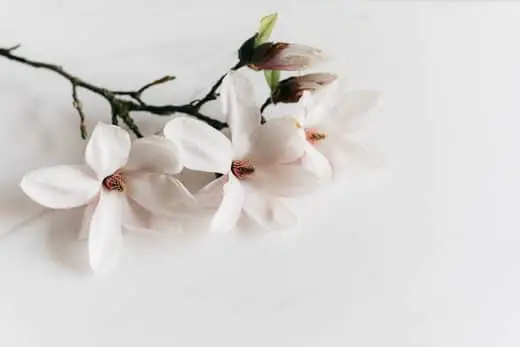
Look up trees with flowers online and no doubt one of the most popular species you will come across are Magnolias.
Their bright white flowers do stand out and also are unique in the sense that they match any indoor decor you can think of.
Whilst a lot of people like to keep Magnolia flowers by themselves, they too can be grown directly from their trees, indoors.
Now Magnolia are traditionally best kept outdoors, however, using a grow light, they can be kept indoors too.
Just maintain a steady cool temperature.
When first growing, I’d consider keeping it in a cool garage to get your tree used to its new environment.
You can then move into its final resting place near a bright window in a room that does not fluctuate in temperature too much.
Magnolia trees – quick facts
Magnolia Stellata | Requirements |
Water | Water if dry to touch - once per day as a minimum. Water once per week in the winter. |
Sunlight | 6 hours of direct sunlight. Full Sun required. Place outdoors for best results. Keep in shade in summer. |
Fertilizer | Once per month in the spring and summer. Avoid in fall/winter. |
Growth rate | Slow, averaging 1-5 inches of growth per year. |
Repotting | Once every 3 years. |
When do Magnolia trees bloom?
Most Magnolia subspecies will tend to bloom in the spring and summer, between May and August. Magnolia tends to only produce one batch of flowers per year.
What color are Magnolia flowers?
Magnolias typically come in bright white or creamy whites. Some newer species have been modified to come in blue and red varieties such as Baby Blue Magnolias.
Advantages and disadvantages of Magnolia
The main advantages of Magnolia are:
- Insect-free – Magnolia is usually good at preventing themselves from common pest infections unless they have underlying issues like mold disease.
- Best magnolia – Whilst other Magnolia species can be used for keeping indoors, they are more shrub-like than tree-like. The stellata verity is easily the best option for growing indoors. This is because they grow quickly and do not take 30 years to reach full maturity.
- Long bloom – The white flowers these trees produce, start blooming in May to the fall in September.
- Winter-proof – These trees are hardy and so can be kept both in outdoor and indoor conditions.
The main disadvantages of Magnolia are:
- Slow growing – These trees can take 10 to 15 years to reach full bonsai maturity if you want to grow them into bonsai trees and can take a long time to grow before you see results if growing indoors by themselves.
- Better for larger trees – Magnolias tend to grow large meaning they can take up a fair bit of room. Keep then if you have a larger indoor living room space.
Jasmin
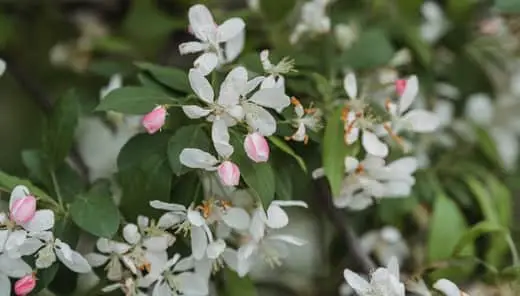
Jasmin trees, also commonly known as Gardenia trees are also incredibly popular.
These trees are a staple in South and South-East Asia and are regularly kept indoors.
Its petals have a distinct sweet smell and can really add to the ambiance of a living room.
Jasmin trees are also relatively easy growing and easy to keep, especially if you buy a Jasmin Tree for a store.
As such, they can make perfect options if this is the first flowering indoor tree you are purchasing.
Jasmin trees also prefer warmer temperatures meaning that they can be kept indoors pretty much year-round.
Jasmin trees – quick facts
Jasmine | Requirements |
Water | Water if dry to touch - once per day as a minimum. Water once per week in the winter. Water with rainwater if possible. |
Sunlight | 4 hours sunlight. Avoid direct sunlight. Keep in the shade for best results. Move indoors during the winter. |
Fertilizer | Twice per month in the spring and summer. Once per month in the fall and winter. |
Growth rate | Medium, growing 5 to 12 inches per year. |
Repotting | Once every 3 years. |
When do Jasmin trees bloom?
Most Jasmin will bloom from June to September, during the summer months. Jasmin trees however will most commonly bloom in clusters, and it is not uncommon for some Jasmin to bloom from early spring to late fall.
What color are Jasmin flowers?
Jasmin flowers are most commonly white. Other color varieties that are also commonplace however include cream and yellow. Other colors such as black or red varieties of Jasmin do not exist.
Advantages and disadvantages of Jasmin
The main advantages of jasmine are:
- Plenty of flowers – This tree has plenty of flowers meaning you won’t have to worry about not having a high yield of flowers indoors.
- Pleasant smell – Not only will your bonsai tree have beautiful white flowers if you opt for Jasmin, but you will also have a nice smelling tree.
- Commonplace – A lot of people opt for gardenia jasmine bonsai trees due to their flowers, making the amount of knowledge to care for these trees commonplace.
- Easily propagated – Jasmin can be grown easily, in most climates, from seed or cutting.
The main disadvantages of Jasmin are:
- Insect attack – Aphids, spider mites, and caterpillars are commonly found eating on this tree’s leaves.
- Prefer rainwater – Due to the tree being an acid-loving tree, use rainwater to water if possible.
- Yellowing leaves – Jasmin bonsai are prone to chlorosis.
Eucryphia Nymansensis
Now despite having, probably the most overly complicated name in plant and tree history, Eucryphia Nymansensis, also known as Nymansy, is a great option for a flowering indoor tree.
It produces bright fluffy flowers, that can reach 6cm in diameter and are very easy-going trees, making them ideal for beginners.
These trees are also beneficial in the sense that they are disease and pest free in most cases meaning you won’t have to worry about any critters running around your house when you bing this tree indoors.
Eucryphia Nymansensis – quick facts
Eucryphia Nymansensis | Requirements |
Water | Water if dry to touch - twice per week usually works well. |
Sunlight | 4 hours sunlight. Avoid direct sunlight. Keep in the shade for best results. Move indoors during the winter. |
Fertilizer | Twice per month in the spring and summer. Once per month in the fall and winter. |
Growth rate | Medium, growing 5 to 12 inches per year. |
Repotting | Once every 3 years. |
When does Eucryphia Nymansensis bloom?
Eucryphia Nymansensis typically bloom flowers in the later summer and early fall. Most trees then will produce flowers between June and September.
What color are Eucryphia Nymansensis flowers?
Eucryphia Nymansensis flowers are white with 3 petals and a few spots located in the center of the flower. Eucryphia Nymansensis does not come in other color variations.
Advantages and disadvantages of Eucryphia Nymansensis
The main advantages of Eucryphia Nymansensis are:
- Low pest and infections – These trees have natural defense mechanisms against pests and mold infections ensuring they can grow healthily
- Easy to care for –These trees do not require a lot of maintenance, meaning they can very much be a set and forget type of indoor tree.
- Evergreen – Meaning the tree will have leaves year-round – regardless of if you keep it indoors or outdoors
The main disadvantages of Eucryphia Nymansensis are:
- Can grow large – This tree can exceed 12 meters meaning if left unchecked you will need a very large indoor space to keep this tree in.
- More of a shrub – Whilst this does look like a tree, it is very much shrub-like meaning it can be more difficult to try and manage if pruning.
Chinese Redbud
If you want to add a tree that has the aesthetic of the far-east to your home, whilst still having a tree that boasts bright flowers that catch your eye, then look no further than the Chinese Redbud.
This tree is incredibly robust and can be grown in both outdoor and indoor climates.
It is great at being grown in both tropical and temperate climates making it perfect for an all-round tree.
Chinese Redbud- quick facts
Chinese Redbud | Requirements |
Water | Water if dry to touch - Twice per week is usually enough. |
Sunlight | 4 to 6 hours of direct sunlight. Needs cooler temperatures in winter for the flowers to bloom. |
Fertilizer | Once per month in the spring and summer |
Growth rate | Slow - 3 to 5 inches of growth per year |
Repotting | Once every 5 years or so |
When does Chienese Redbud bloom?
Chinese redbud typically blooms from Spring to fall March to September. Its flowers will bloom across the thin branches of the tree from the trunk to the tip of its branches. It is not uncommon for a single Chinese Redbud to produce hundreds of flowers.
What color are Chinese Redbud flowers?
Chinese Redbud flowers are most commonly found in bright magenta, purple and pink. A white Chinese Redbud variety called Shirobana is also available.
Advantages and disadvantages of Chinese Redbud
The main advantages of the Chinese Redbud include:
- Easy to grow – This means if you are a beginner you should have to worry about any special techniques to get this tree to grow.
- Not common – A lot of peoples tick to regular indoor trees. As such, Chinese Redbuds are very uncommon and so can differentiate your indoor space.
Disadvantages of Chinese Redbud include:
- Can grow big – These trees, if left unpruned can grow to 300cm – this can deftly eat up the space you have indoors
- Will leave a mess – During the fall when the flowers start to drop they will leave a mess. This is mainly due to there being so many flowers that each tree produces.
- Need to be left undistributed – once plated in a pot leave this tree alone. This is because they are very sensitive to subtle changes.
Crabapple
Finally, if you want to grow a tree that produced edible flowers then, believe it or not, you can grow Crabapple trees indoors too.
Crab apple trees produce bright white, pink, and red flowers that dart across this tree.
Whilst fruit trees like this are successfully grown outdoors, these can be miniaturized in things like bonsai and grown successfully in indoor conditions too.
Crabapple tree – quick facts
Apple bonsai tree requirements | Explained |
Water | Water once per day in the spring, only if the soil is dry to touch, During the summer and hot conditions watering several times a day may be required. Use moisture trays or place your pot in a bowl of shallow water to prevent it from drying out. Water once per week in winter as a rule of thumb. More watering is required when fruiting. |
Sunlight | Direct sunlight for 6 hours per day during the spring and summer. Place in the shade/semi-shade during the brightest weeks of the year. |
Temperature | Between 40 degrees F and 90 degrees F. Although they can survive in warmer and cooler conditions for limited periods. If temperatures drop below, ensure the roots are protected by mulch |
Fertilizer | Fertilize with organic fertilizer once every 6 weeks. Liquid fertilizer can also be used, however, aim for lower nitrogen levels which will cause the tree to grow as opposed to the fruit. |
Repotting | Once per year in the spring. |
Placement | Outdoors only |
Species Type | Deciduous |
Wire type | Both copper and aluminum |
Time to grow from seed | 5 years |
Potting Soil | Inorganic mix of akadama and volcanic ash rock. Organic soil such as peat soil can also be used. |
Growth type | Fast-growing, adding 12-36 inches of growth per year when young. This then slows down after 5 years or so to a medium-growing bonsai. |
Size | Medium to large, most trees sold is typically two hand bonsai. |
Lifespan | 50 to 100 years if used for bonsai (30 to 50 years if not used for bonsai) |
When do crabapple trees bloom flowers?
The Crabapple tree will typically bloom flowers in the spring, between March and May. Thes flowers will dissipate after a few weeks as the tree prepares to start producing fruit which will be ready to harvest in the fall.
What color are the flowers on a Crabapple tree?
Crabapple tree flowers come in a wide variety of colors but white, pink, red, and cream are the most common. Crabapple fruit also comes in similar colors with purple, orange, yellow, and scarlet verities additionally being commonplace.
Advantages and disadvantages of Crabapple Trees
The main advantages of Crabapple trees are:
- They produce fruit – Meaning not only will you have an indoor tree with beautiful flowers, but they can also produce edible fruit.
- Easy to transform into bonsai – For those of you who want to grow a fruit bonsai tree you’re in luck, Crab apples are commonly used for and transformed into bonsai.
- Fast-growing – These trees can typically mature in 3 to 5 years and so will start producing fruit and flowers in a relatively short space of time.
The main disadvantages of Crabapple Trees are:
- Insect infestation – Due to the fruit and flowers, theta is more susceptible to pests infestation
- Require some skill to grow – Like a lot of fruit trees, these are not beginner-friendly as the fruit they produce requires an extra level of care.
- Harder to grow indoors – Crabapples prefer warmer conditions- even when being kept indoors, as such grow lights should be invested in if you want to grow one of these successfully.
What flowering trees should you avoid?
Willow trees that produce Catakins should be avoided when kept indoors. These trees require a lot of sunlight and water requirements which cannot be met in Indoor conditions. Azalea trees should also be avoided if you have dogs and cats as they can prove toxic.
What is the best flowering indoor tree?
The best flowering indoor tree has to be Fukien Tea Trees. These trees produce small white flowers year-round and are very low maintenance, and can survive even if over and underwatered.
Which flowering indoor tree is beginner-friendly?
Fukien tea trees are very beginner-friendly. They are naturally good at repelling pests and diseases, and only require a few hours of direct sunlight every day which can be easily achieved by keeping them near a window.
Which indoor flowering tree makes the best bonsai?
Fukien tea trees make for fantastic indoor flowering bonsai trees. these trees are very easy to prune and shape, making them ideal for use in bonsai. Crab-apple, Serissa, and Cherry Blossom also make for fantastic bonsai trees.
How to care for flowering indoor trees?
So now you know what the best indoor flowering trees are what are some quick tips you should follow to grow your indoor flowering trees successfully.
Hopefully, the advice below should help:
- Moisture – Most indoor flowering trees should be wartered when the topsoil is dry to touch. Most trees will typically have dry soil after about 3 days when being kept at a steady temperature.
- Sunlight – Indoor glowering trees will typically require less light than their outdoor tree counterparts. That being said, aim to keep these near a bright window where they can review between 4 to 6 hours of direct sunlight. In the fall or winter when sunlight levels may drop, consider using a grow light.
- Repotting – The majority of indoor flowering trees are relatively slow-growing, meaning you won’t have to worry about repotting these trees too often. That being said, every 3 to 4 years, you should consider repotting your tree to prevent the roots from outgrowing the tree – which can lead to nutrient damage.
- Fertilizer – All of the tree species in this post will benefit from fertilizing once per month – mainly in the spring and summer growing seasons.
- Pests – Whilst keeping these trees indoors will greatly reduce the chances of getting an insect infestation, it is still common. That being said, inspect your tree weekly for signs of Aphids, Weevils, Caterpillars, Spider Mites, and Scale, all of which thrive on indoor tree species.
A survey on the best indoor flowering tree
Finally, I asked 20 plant paladin readers who own indoor flowering trees, what their thoughts on the best indoor flowering trees are.
To summarize:
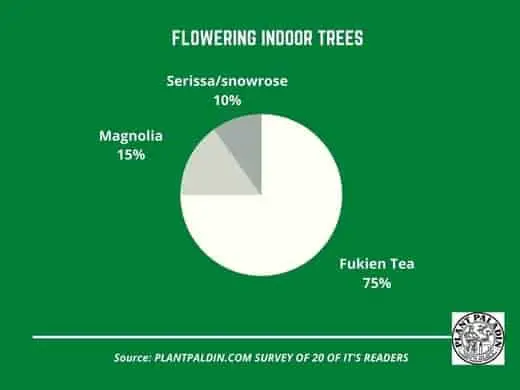
My top picks for the gear you will need!
So like I mentioned earlier, over the past three years of running PlantPaladin, hundreds of people have asked me for my recommendations on the best bonsai gear on the market.
Having spent thousands of dollars on bonsai items these past few years and tested at least 100 bonsai-specific products, I’ve listed my favorite products below – All of which I highly recommend and think you can get great value.
They can purchase directly by clicking the link to take them to Amazon.
Bonsai Tool Set: One of the significant challenges I’ve had is finding a toolset that was not only durable but didn’t break the bank. SOLIGT has recently developed a fantastic bonsai tool set that covers all the tools you need to trim, prune, and repot your trees. – You can grab it here.
Complete Bonsai Set: Many of you will want to grow your bonsai trees entirely from scratch, but finding the varicose seeds, pots, and other items in one place can be challenging. Leaves and Sole then have created a complete bonsai set that I’ve personally used that ticks all the boxes. You can grab it here.
Bonsai wire: The number of times I’ve run out of wire for my bonsai or purchased cheap bonsai wire that doesn’t do the job is embarrassing for me to admit. After a lot of trial and error, I found that using Hotop’s aluminum bonsai wire is one of the best options on the market. This can easily be used for both indoor and outdoor bonsai. You can grab it here.
This post was written by Fehed Nicass who has been passionate about bonsai for over 3 years. He currently resides in the UK and works in sales.
